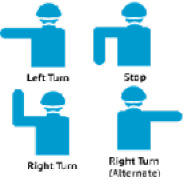Sharing the Road With Bicycles
Bicycle riding is an important type of transportation, particularly for traveling to work and to school. Because bicyclists may be on any road at any time, drivers must always be alert for bicycle traffic.
Bike-car crashes often happen because drivers do not see bicyclists soon enough. In Georgia, as in other states, most crashes occur during daylight hours on straight, dry roads, typically near intersections or driveways.
Bicyclists are legally entitled to use every road in Georgia except the interstate and interstate-like highways (limited access highways). The law allows bicyclists use of the full lane. They are not required to be in a bike lane even when one is present. Although their slower pace may slow motorists occasionally, it is important for drivers to respect the bicyclist’s right to be there. Yield the right of way to the bicyclist in the same way that you would yield to another motorist. If possible, make eye contact with the bicyclist, especially at intersections.
Road defects cause more problems for bicycles than for cars. When passing a bicycle rider, leave the bicyclist plenty of room in case he or she has to swerve to miss a pothole or other danger in the road. The minimum legal space for a motorist to pass a bicyclist is 3 feet.
Important Reminders Concerning Bicycle Riders
- At intersections, wait until the bicyclist is out of the intersection before making a turn;
- When passing a bicyclist, slow down and make sure the rider is aware of your presence. Leave at least three feet between the bicycle and your vehicle and only pass when it is safe to do so. If there is not enough room to pass because of oncoming traffic, wait until conditions are safe for passing;
- Watch for bicyclists who may appear to suddenly swerve or turn in front of you. Bicyclists sometimes forget or do not have the opportunity to merge left due to traffic speed, in order to be in the left turn position.;
- Night time bicyclists will not always have lights, and some may not even have reflectors. If you meet an oncoming bicyclist, please dim your lights to avoid blinding the bicyclist.
- Bike lanes and any other bicycle infrastructure are for the use of bicycles only. Motorists are not to drive or park in a bike lane.
- Bicyclists are able to pass on the right side of motorists if there is a dedicated lane or sufficient room in a shared lane, and it is safe to do so.
Arm Signals Used by Bicyclists
Bicyclists should use their arms to signal to other motorists when they are going to make a turn, and the direction of the turn or when they are slowing or stopping. The signals used by bicyclists are listed below:

